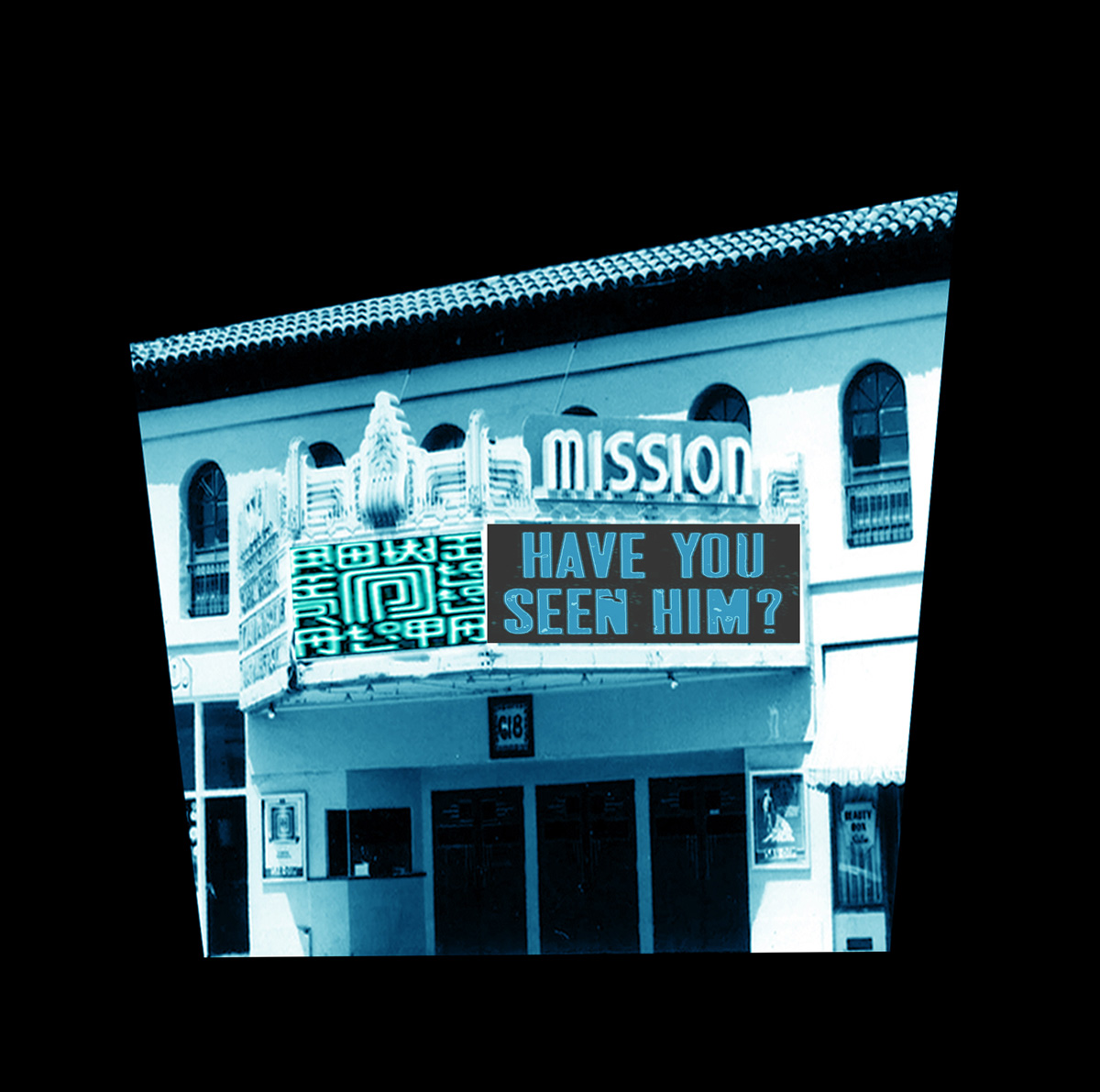
Chapter 4
Finding Animal Chin
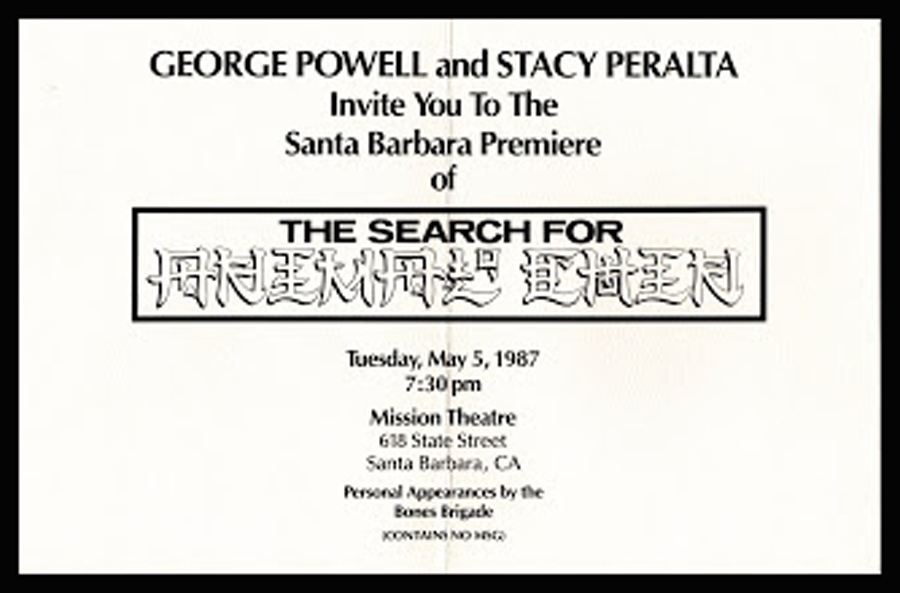
Well, then this fateful thing began to unfold for us. This time, JW needed a job, and what he found was the portal to our big new adventure. He went to work at the local surf and skate store there in Carpinteria called the "Sunshine Store." One day, in the spring of 1987, his boss Bernie gave him two complimentary tickets to the "Premiere" of a new skateboard video produced by a big skateboard manufacturer based in Santa Barbara, Powell-Peralta. Being a great son, he wanted to keep me involved, so he offered me the other ticket.
Down the rabbit hole we went.
The Santa Barbara premiere was held in the old Mission Theater on lower State Street that has since been torn down. It wasn't an event you could buy a ticket for. All these kids had some connection to the people who made their living through, or had some committed involvement in the Santa Barbara skateboard world. The line went down the block; there were mostly excited young skaters like JW, and a few older skaters, and skateshop owners. When we entered, each person was handed a soda and a box of popcorn and as we turned to go to our seats, there in the middle of this swarming lobby was a white haired and bearded gentlemen who I immediately recognized as a nearly mythical figure out of my past, looking exactly as he did when I had seen him last, decades before. His name was Vernon Johnson...In the 1950's he created quite a stir by purchasing an old Santa Barbara Transit Co. bus, loading his whole family, his wife and eight kids in it, and going for a tour across Russia!
This man may have saved us all from nuclear annihilation. In September of 1959, Nikita Khrushchev, premier of the Soviet Union, was visiting the United States. The premier had in his power the ability to set off World War III, a worldwide conflagration.
I lived in Carpinteria the last three years of high school. Khrushchev would be passing through town on a train. The press was reporting that he was miffed by not being allowed to visit Disneyland due to security concerns, and generally having a rotten time in Los Angeles, with crowds of protestors throwing tomatoes at his limousine and in the dust-up about that in the days that followed, a grumpy Khrushchev was taking his planned high security train trip up our scenic coast. He was having a very bad time.
Escorted by helicopters, a two-train caravan rumbled on through town and on toward Santa Barbara. It was strange. This was the man who had proclaimed to the West, "We will bury you," a year before. At school, fire drills routinely alternated with nuclear attack drills. This was the man whose bombs we practiced ducking under our desks to shield ourselves from. Two years earlier, the USSR had launched their Sputnik satellite, the first man-made object in earth orbit. The American space efforts were definitely behind, and it was proof that our foremost Cold War adversary could deliver a nuclear bomb to anyplace in the world. This was the man who could make the order. He was riding through town on a sunny September Sunday, and it didn't seem fearful. I watched him go by down where the little railroad bridge at the slough crosses Carpinteria Creek near the ocean. I was lying on the ice-plant-covered sand dune at the beach camp, and there he goes: the great bogeyman.
In Santa Barbara, it was wondered if he would be in a good enough mood to even get off the train to greet local dignitaries. When the train stopped it was reported that he sat there glowering until he had became aware of a smiling bearded face in the crowd. Only then did he decide to get off the train. He got out, and after a perfunctory shaking of hands with the mayor; he oddly singled out the man in the crowd who looked interesting to him, the man with a short white beard. They had a brief exchange through an interpreter in which the bearded one welcomed him to Santa Barbara and expressed an interest in visiting Russia. And the chairman of the Union of Soviet Socialists Republic said, to the effect, "Come on over."
Khrushchev's mood was decidedly elevated by this short conversation, and World War III never happened.
The following year this man, Vernon Johnson, with his wife and eight kids, left California on a personal good will mission, driving across the U.S, then a ship to Italy, then driving up through Europe and on to a momentary encounter with Khrushchev in Moscow. During the Cuban Missile Crisis, just two years later, his finger hovered over the doomsday button. How could he incinerate the Johnsons?
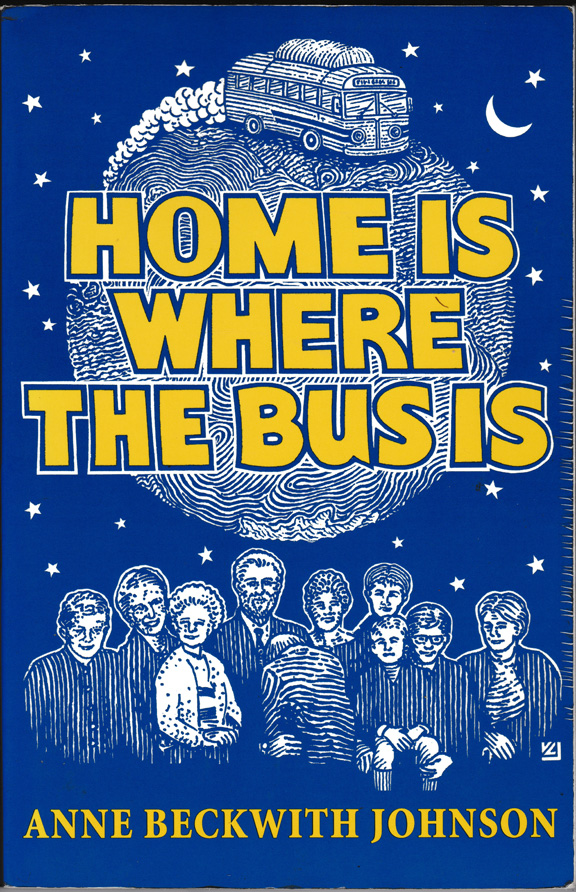
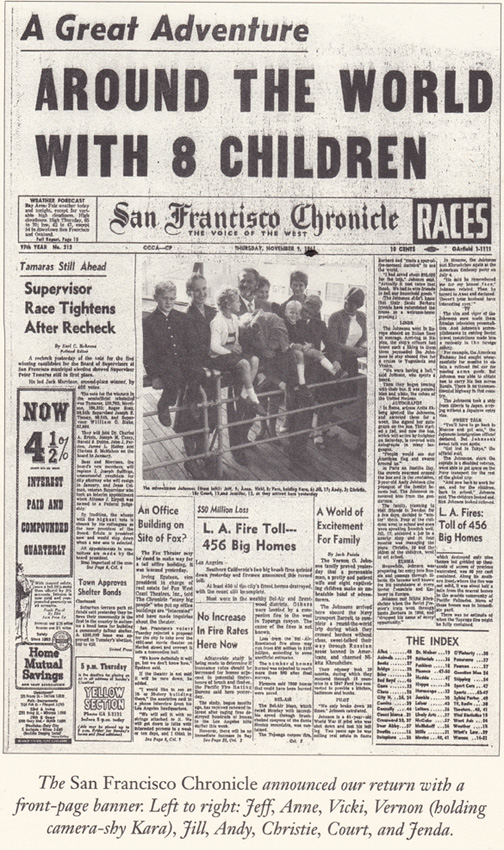
It was a very bizarre but far-sighted thing to be doing at the height of the Cold War, to be cutting through the crap like that. In the public schools there were entire programs of political paranoia coaching us as to how to spot propaganda being directed at us (we learned, all right); with fire drills we marched outside and lined up on the playground; with nuclear blast drills we dove under our desks "keep your backs to the windows, there will be flying glass and an eyeball destroying blinding flash." So in the midst of the hype of this Russian-atheist-Communist-menace, one guy turns to his wife and says, "Why don't we load all the kids in a bus and go half way around the world and see for ourselves?" And she says, "OK", and off they go.
Well, after a while they come back alive and were a feature in the local newspaper for a time, but then I didn't hear about them for a few years. I'm not sure when, but they next came on my radar when they were central in building a village of small non-code structures in the area of Hollister Ranch where they were experimenting with different communal arrangements, another ahead-of-the-times thing to be doing in the early sixties, until the Sheriff's Department, Health Department and Building Department showed up to close them down. They were non-conformists, like beatniks, only optimistic. They were hippies before the word had been coined. Bohemians you might say, free thinkers. Life as an experimental adventure.
A few years later, I was 18 in 1962 and alternating between college and surfing escapades and work. I had landed a job as a gopher for a real estate broker in Santa Barbara; collecting rents, placing ads, setting up For Sale signs, plowing the weeds under on a vacant lot; stuff like that. I was doing that for only a couple months when the broker tells me he's not going to do real estate anymore, because a friend of his is running for Congress and he's going to put everything into that...and this friend is: Vern Johnson.
So for the next few months, I was paid the same rate to be a campaign gopher for this local legend. To make a long story short, I had a grand adventure, got my young brain spun around in many curious and unexpected ways, and when VJ lost the election, I went back to UCSB and eventually changed my focus to Political Science and Eastern philosophy. Most of all, the lesson was that life could be, should be, built around the pursuit of happiness, beyond the boundaries of what has come before, and love for however big a family as you can conceive yourself being a part of.
Then, quarter of a century later, I returned to Santa Barbara with my own teenage son and there in the middle of a crowd of excited skateboarders stands Vern Johnson, beaming with bliss at the whole spectacle ...with white hair and short white beard, he looks exactly as he did the last time I saw him about twenty-five years before. I go up and shake his hand and explain how it is that I recognize him and we have a few laughs as the mob swarms past us. I find out why he's here. He says that he's "part of the family" in this skateboard company. The fact that he's there gives me a feeling this night is fateful, as it has turned out to be. He was always ahead of his time and at this moment he's the symbolic patriarch of this skateboard scene. As I learned later, it turns out that three of those kids he took with him across Russia were part of that skateboard company. One daughter, Christie, was married to the company president, George Powell; another daughter, Jill, was the company's buyer, and his son, Court Johnson, VCJ, was the company's artist, creator of most of the logos adorning the skateboards, wheels, stickers and t-shirts.
The theater was packed with excited young skaters; a large video projector was propped on some seats in the middle, ready to go. Someone named Stacy Peralta was introduced and cheers went up in the crowd. He was the director of the movie, and known pretty much as one the first skateboarders to actually make a career of it. He was a hero to all these kids. He had invented being a skateboard pro. He was "older" now, in his late twenties, and had gathered a team of younger skaters, "The Bones Brigade."
Well, the video was called, The Search For Animal Chin...and the thin plot is that a group of skaters are trying to catch up with an elusive sort of Zen master of skateboarding. The supposed search for him in various parts of California, Nevada and Hawaii was an excuse to show off these five professional skaters in some great skate spots...They never do catch up with Animal Chin, but the point of the allegory is a journey in search of fun...search for the sweet spots...pursuit of happiness...which is what skateboarding is all about, and for me, what ramp building was all about.
The five skaters featured in this video, besides being astounding athletes, are fine human beings as well, and having eventually met each of them briefly, and followed their careers over the years, I know each of them to be a class act. This was a remarkable collection of photogenic and charismatic good people.
The movie begins with a grinning skeleton, ripping through the black screen, exposing his skull, posing like the MGM lion, and then laughing hoarsely in the place of the lion's roar. From the very beginning, the film mocks every part of the pop culture it portrays, including mocking itself. This movie is a funny, corny, hokie, high camp masterpiece. It's a feature length put-on. The acting ranges from reluctant, to amateurish and occasionally inspired, simply because the characters are not actors, they are playing themselves. The special effects are intentionally transparent and low tech. The soundtrack music was original and exceptional. If the goal was to present skating in its most accessible form, they nailed it. The five members of the "Bones Brigade" were a mismatched collection of skaters, exactly the same kind of mixture that JW and every young skater was experiencing with his own local mismatched brigade of buddies from his own neighborhood.
The production had the feel of a movie created by the teenage skaters that it featured. Its genius is cloaked in silliness. Genius might not be the word for it, since years later I learned that Stacy was surprised to see Animal Chin become such big success and an influence on so many people. As a professional, its flaws were glaring to him, but invisible to the rest of us. So some of the movie's genius was accidental, but unmistakable is the truth in its portrayal of the joy of skating, and of being a skater, and it totally worked for JW and me.
There is nothing in the plot line that involves worldly pedestrian motives. Not sex, not drugs, not money, romance, greed or power, not even good or evil. It's propelled by the rolling pursuit of fun. If it were a surf movie, the settings would be distant and exotic surf spots out of reach of your average American kid. In the world of Animal Chin, all the destinations: the ditches, sidewalks, backyard ramps, and empty swimming pools are part of a skater's everyday environment. Even as much as the film is a preadolescent fantasy, it has the edginess that the skating itself is real, and beyond acting. The skating is absolutely genuine, impossible to fake, and physically dangerous and obviously really, really fun. And ordinary kids were the world champions of it. All they needed was this simple set up...a skateboard, trucks, bearings and wheels. The world champs rode the same equipment that any kid could buy in his local skateshop...the exact same equipment. Powell-Peralta products, top quality, ran about $150.
Well, anyway, in the theater there I'm enjoying myself having some easy laughs and marveling at the skills of the "Bones Brigade." I'm getting a better idea of what a skater can do, and charmed by the similarities of a skate safari to the surf trips I used to take up and down this coast. Toward the end of the video the skaters arrive at "The Chin Ramp." When I see this thing I'm amazed and startled, and I'm hit with the sinking feeling in my gut that I had missed out on being in on the building of something never to be repeated...an "I got-here-just-a-little-too-late" sort of feeling. It was huge, and had been built solely for the video and was torn down a few weeks after filming.
When we left the theater that night, I came away with three revelations. First, the Bones Brigade riders had showcased skating way beyond what I could have imagined physically; their skills were mind-boggling. Second, with this new idea of what was possible, I had more of a street skater's eye, and as I went about my everyday travels, I was able to see the possibilities presented by this asphalt and concrete surf that's everywhere. So, when driving for JW and his pals, exploring the back roads and alleys of Southern California I had a new perspective, I knew what to look for. The third idea was that I really, really wanted to participate in the building of something on the level of that Chin Ramp.
We didn't have a VCR at the time, but I bought a copy of the video before we left the theater anyway. It was early May, and when JW and I went back to Hawaii that summer a month later, we took that copy of Animal Chin with us, showed it all around to our pals. We must have watched it 15 times. To us, it was a life-changing work of art. JW got to drawing pictures of the Chin Ramp and we worked out the dimensions as best we could from freeze-framing the tape and counting the seams in the 4' x 8' sheets of plywood.
When we got back from Hawaii at the end of that summer, I needed a job. Powell Corporation had put a classified ad in the Santa Barbara News-Press for a "facilities carpenter." I think I was the first one to answer the ad. It was like going to a movie, and then going to live inside the movie.
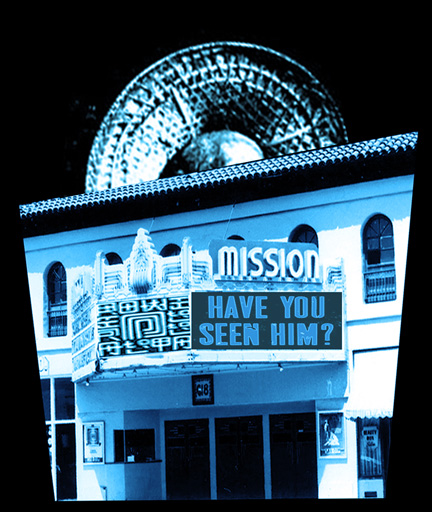
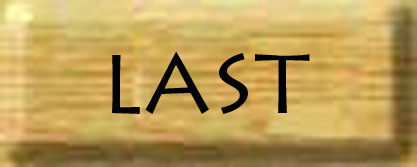

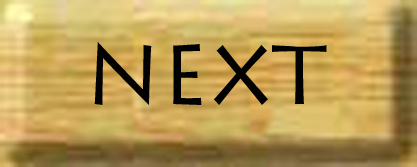
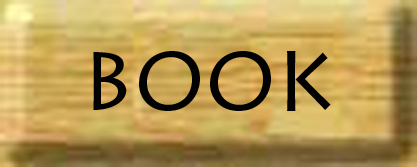
© 2017 John Oliver
All Rights Reserved
mail@unclejohnsweb.com
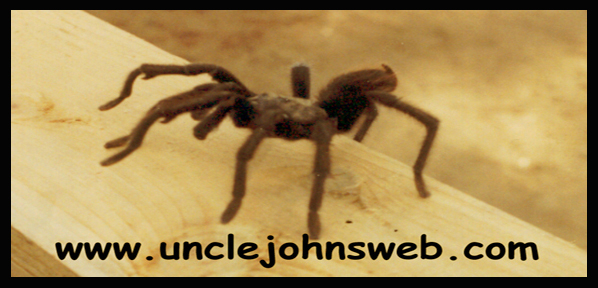
Down the rabbit hole we went.
The Santa Barbara premiere was held in the old Mission Theater on lower State Street that has since been torn down. It wasn't an event you could buy a ticket for. All these kids had some connection to the people who made their living through, or had some committed involvement in the Santa Barbara skateboard world. The line went down the block; there were mostly excited young skaters like JW, and a few older skaters, and skateshop owners. When we entered, each person was handed a soda and a box of popcorn and as we turned to go to our seats, there in the middle of this swarming lobby was a white haired and bearded gentlemen who I immediately recognized as a nearly mythical figure out of my past, looking exactly as he did when I had seen him last, decades before. His name was Vernon Johnson...In the 1950's he created quite a stir by purchasing an old Santa Barbara Transit Co. bus, loading his whole family, his wife and eight kids in it, and going for a tour across Russia! This man may have saved us all from nuclear annihilation. In September of 1959, Nikita Khrushchev, premier of the Soviet Union, was visiting the United States. The premier had in his power the ability to set off World War III, a worldwide conflagration.
I lived in Carpinteria the last three years of high school. Khrushchev would be passing through town on a train. The press was reporting that he was miffed by not being allowed to visit Disneyland due to security concerns, and generally having a rotten time in Los Angeles, with crowds of protestors throwing tomatoes at his limousine and in the dust-up about that in the days that followed, a grumpy Khrushchev was taking his planned high security train trip up our scenic coast. He was having a very bad time.
Escorted by helicopters, a two-train caravan rumbled on through town and on toward Santa Barbara. It was strange. This was the man who had proclaimed to the West, "We will bury you," a year before. At school, fire drills routinely alternated with nuclear attack drills. This was the man whose bombs we practiced ducking under our desks to shield ourselves from. Two years earlier, the USSR had launched their Sputnik satellite, the first man-made object in earth orbit. The American space efforts were definitely behind, and it was proof that our foremost Cold War adversary could deliver a nuclear bomb to anyplace in the world. This was the man who could make the order. He was riding through town on a sunny September Sunday, and it didn't seem fearful. I watched him go by down where the little railroad bridge at the slough crosses Carpinteria Creek near the ocean. I was lying on the ice-plant-covered sand dune at the beach camp, and there he goes: the great bogeyman.
In Santa Barbara, it was wondered if he would be in a good enough mood to even get off the train to greet local dignitaries. When the train stopped it was reported that he sat there glowering until he had became aware of a smiling bearded face in the crowd. Only then did he decide to get off the train. He got out, and after a perfunctory shaking of hands with the mayor; he oddly singled out the man in the crowd who looked interesting to him, the man with a short white beard. They had a brief exchange through an interpreter in which the bearded one welcomed him to Santa Barbara and expressed an interest in visiting Russia. And the chairman of the Union of Soviet Socialists Republic said, to the effect, "Come on over."
Khrushchev's mood was decidedly elevated by this short conversation, and World War III never happened.
The following year this man, Vernon Johnson, with his wife and eight kids, left California on a personal good will mission, driving across the U.S, then a ship to Italy, then driving up through Europe and on to a momentary encounter with Khrushchev in Moscow. During the Cuban Missile Crisis, just two years later, his finger hovered over the doomsday button. How could he incinerate the Johnsons?


A few years later, I was 18 in 1962 and alternating between college and surfing escapades and work. I had landed a job as a gopher for a real estate broker in Santa Barbara; collecting rents, placing ads, setting up For Sale signs, plowing the weeds under on a vacant lot; stuff like that. I was doing that for only a couple months when the broker tells me he's not going to do real estate anymore, because a friend of his is running for Congress and he's going to put everything into that...and this friend is: Vern Johnson.
So for the next few months, I was paid the same rate to be a campaign gopher for this local legend. To make a long story short, I had a grand adventure, got my young brain spun around in many curious and unexpected ways, and when VJ lost the election, I went back to UCSB and eventually changed my focus to Political Science and Eastern philosophy. Most of all, the lesson was that life could be, should be, built around the pursuit of happiness, beyond the boundaries of what has come before, and love for however big a family as you can conceive yourself being a part of.
Then, quarter of a century later, I returned to Santa Barbara with my own teenage son and there in the middle of a crowd of excited skateboarders stands Vern Johnson, beaming with bliss at the whole spectacle ...with white hair and short white beard, he looks exactly as he did the last time I saw him about twenty-five years before. I go up and shake his hand and explain how it is that I recognize him and we have a few laughs as the mob swarms past us. I find out why he's here. He says that he's "part of the family" in this skateboard company. The fact that he's there gives me a feeling this night is fateful, as it has turned out to be. He was always ahead of his time and at this moment he's the symbolic patriarch of this skateboard scene. As I learned later, it turns out that three of those kids he took with him across Russia were part of that skateboard company. One daughter, Christie, was married to the company president, George Powell; another daughter, Jill, was the company's buyer, and his son, Court Johnson, VCJ, was the company's artist, creator of most of the logos adorning the skateboards, wheels, stickers and t-shirts.
The theater was packed with excited young skaters; a large video projector was propped on some seats in the middle, ready to go. Someone named Stacy Peralta was introduced and cheers went up in the crowd. He was the director of the movie, and known pretty much as one the first skateboarders to actually make a career of it. He was a hero to all these kids. He had invented being a skateboard pro. He was "older" now, in his late twenties, and had gathered a team of younger skaters, "The Bones Brigade."
Well, the video was called, The Search For Animal Chin...and the thin plot is that a group of skaters are trying to catch up with an elusive sort of Zen master of skateboarding. The supposed search for him in various parts of California, Nevada and Hawaii was an excuse to show off these five professional skaters in some great skate spots...They never do catch up with Animal Chin, but the point of the allegory is a journey in search of fun...search for the sweet spots...pursuit of happiness...which is what skateboarding is all about, and for me, what ramp building was all about.
The five skaters featured in this video, besides being astounding athletes, are fine human beings as well, and having eventually met each of them briefly, and followed their careers over the years, I know each of them to be a class act. This was a remarkable collection of photogenic and charismatic good people.
The movie begins with a grinning skeleton, ripping through the black screen, exposing his skull, posing like the MGM lion, and then laughing hoarsely in the place of the lion's roar. From the very beginning, the film mocks every part of the pop culture it portrays, including mocking itself. This movie is a funny, corny, hokie, high camp masterpiece. It's a feature length put-on. The acting ranges from reluctant, to amateurish and occasionally inspired, simply because the characters are not actors, they are playing themselves. The special effects are intentionally transparent and low tech. The soundtrack music was original and exceptional. If the goal was to present skating in its most accessible form, they nailed it. The five members of the "Bones Brigade" were a mismatched collection of skaters, exactly the same kind of mixture that JW and every young skater was experiencing with his own local mismatched brigade of buddies from his own neighborhood.
The production had the feel of a movie created by the teenage skaters that it featured. Its genius is cloaked in silliness. Genius might not be the word for it, since years later I learned that Stacy was surprised to see Animal Chin become such big success and an influence on so many people. As a professional, its flaws were glaring to him, but invisible to the rest of us. So some of the movie's genius was accidental, but unmistakable is the truth in its portrayal of the joy of skating, and of being a skater, and it totally worked for JW and me.
There is nothing in the plot line that involves worldly pedestrian motives. Not sex, not drugs, not money, romance, greed or power, not even good or evil. It's propelled by the rolling pursuit of fun. If it were a surf movie, the settings would be distant and exotic surf spots out of reach of your average American kid. In the world of Animal Chin, all the destinations: the ditches, sidewalks, backyard ramps, and empty swimming pools are part of a skater's everyday environment. Even as much as the film is a preadolescent fantasy, it has the edginess that the skating itself is real, and beyond acting. The skating is absolutely genuine, impossible to fake, and physically dangerous and obviously really, really fun. And ordinary kids were the world champions of it. All they needed was this simple set up...a skateboard, trucks, bearings and wheels. The world champs rode the same equipment that any kid could buy in his local skateshop...the exact same equipment. Powell-Peralta products, top quality, ran about $150.
Well, anyway, in the theater there I'm enjoying myself having some easy laughs and marveling at the skills of the "Bones Brigade." I'm getting a better idea of what a skater can do, and charmed by the similarities of a skate safari to the surf trips I used to take up and down this coast. Toward the end of the video the skaters arrive at "The Chin Ramp." When I see this thing I'm amazed and startled, and I'm hit with the sinking feeling in my gut that I had missed out on being in on the building of something never to be repeated...an "I got-here-just-a-little-too-late" sort of feeling. It was huge, and had been built solely for the video and was torn down a few weeks after filming.
When we left the theater that night, I came away with three revelations. First, the Bones Brigade riders had showcased skating way beyond what I could have imagined physically; their skills were mind-boggling. Second, with this new idea of what was possible, I had more of a street skater's eye, and as I went about my everyday travels, I was able to see the possibilities presented by this asphalt and concrete surf that's everywhere. So, when driving for JW and his pals, exploring the back roads and alleys of Southern California I had a new perspective, I knew what to look for. The third idea was that I really, really wanted to participate in the building of something on the level of that Chin Ramp.
We didn't have a VCR at the time, but I bought a copy of the video before we left the theater anyway. It was early May, and when JW and I went back to Hawaii that summer a month later, we took that copy of Animal Chin with us, showed it all around to our pals. We must have watched it 15 times. To us, it was a life-changing work of art. JW got to drawing pictures of the Chin Ramp and we worked out the dimensions as best we could from freeze-framing the tape and counting the seams in the 4' x 8' sheets of plywood.
When we got back from Hawaii at the end of that summer, I needed a job. Powell Corporation had put a classified ad in the Santa Barbara News-Press for a "facilities carpenter." I think I was the first one to answer the ad. It was like going to a movie, and then going to live inside the movie.





© 2017 John Oliver
All Rights Reserved
mail@unclejohnsweb.com

All Rights Reserved
mail@unclejohnsweb.com
